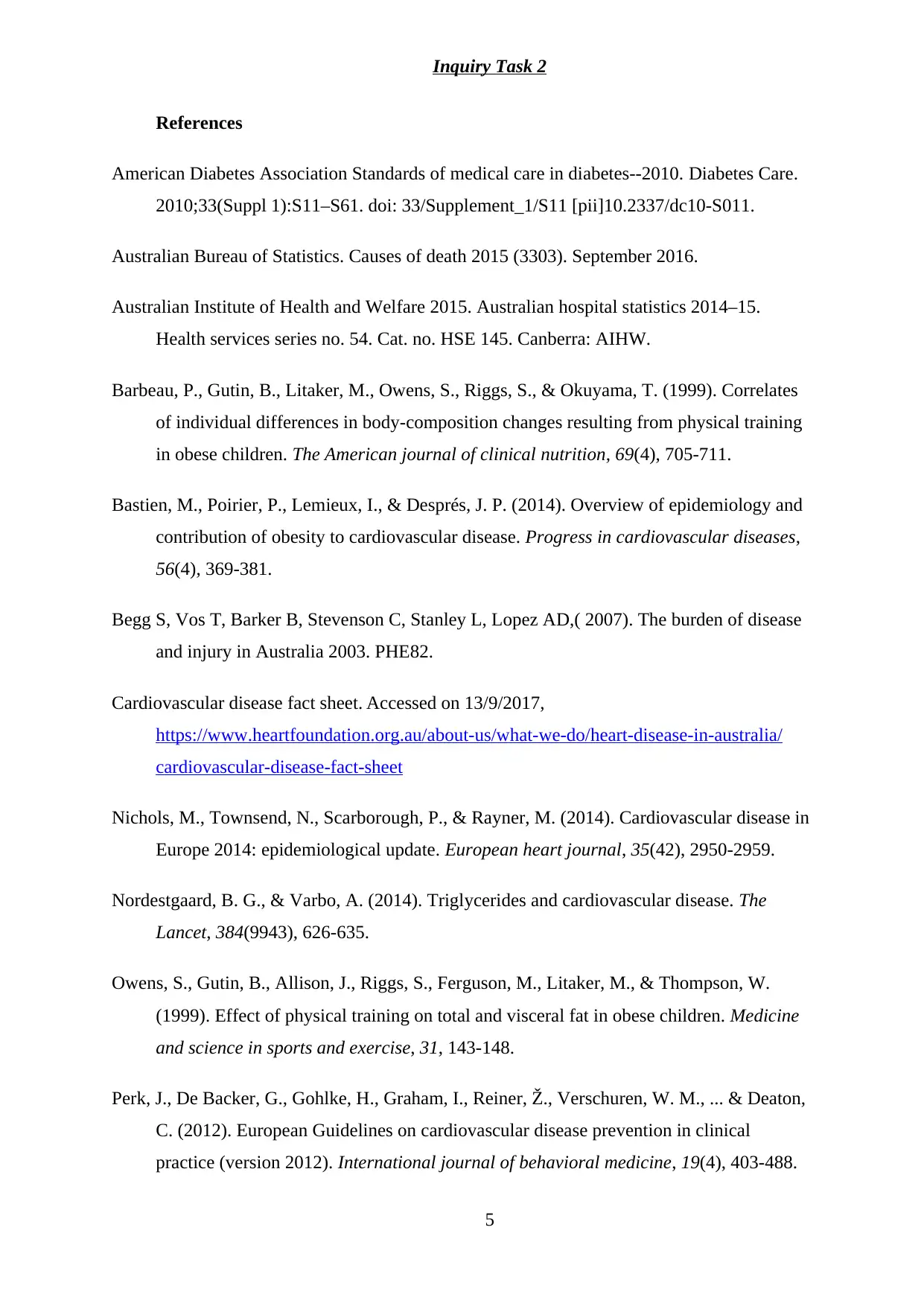Evaluating Cardiovascular Health and Fitness Among Teenagers
VerifiedAdded on 2020/04/07
|5
|1400
|74
AI Summary
Cardiovascular Health and Fitness Among Teenagers is a comprehensive examination of how physical fitness influences heart health in adolescents, addressing risk factors like obesity and sedentary lifestyles. The assignment delves into the crucial role of diet and exercise in preventing cardiovascular diseases (CVD) and highlights strategies for effective intervention. By understanding these elements, we can better promote long-term cardiovascular health among teenagers, reducing their risk of chronic conditions later in life. It discusses how physical activity improves heart function and reduces risk factors such as high blood pressure and cholesterol levels, while a balanced diet supports overall health. Intervention programs that encourage active lifestyles and healthy eating habits are essential for fostering positive health outcomes during these formative years.

UNIVERSITY:
NAME :
STUDENT ID:
COURSE CODE
COURSE NAME
ASSIGNMENT
Inquiry Task II
NAME :
STUDENT ID:
COURSE CODE
COURSE NAME
ASSIGNMENT
Inquiry Task II
Paraphrase This Document
Need a fresh take? Get an instant paraphrase of this document with our AI Paraphraser

Inquiry Task 2
Cardiovascular Health
According to Australian Nutrition organization, cardiovascular health has been referred
to diseases of the heart and the blood vessels. They include coronary diseases, heart attacks,
angina and strokes which are the basic forms of cardiovascular diseases. Often the most
common form of cardiovascular disease is the Atherosclerosis which is attributed to
narrowing of person’s blood vessels responsible of blood and oxygen supply.
Cardiovascular positive health state relates to aspects of proper health care and nutrition
aspects. Often risks factors associated with cardiovascular health include physical inactivity,
high blood pressure, smoking, overweight status, depression, diabetes, high alcohol
consumption and high cholesterol, (Nicholas et al 2014). The key steps which ensure risks
factors management of CVD include healthy eating, regular physical exercise not smoking,
maintenance of healthy weight and limiting amounts of alcohol consumption, (Perk et al
2012).
Cardiovascular fitness among teenagers
Evidence has shown that cardiovascular disease has the ability to cause devastating
consequences on quality of life and cause various chronic diseases among teenagers later in
life. Cardiovascular profiles are found among teenagers with low level of physical fitness. It
is often associated with high levels of body fat and large amounts of body truncal fat
especially those of the adipose tissues, (Nordestgaard & Varbo, 2014). Thus with the
concern of primary prevention and public health safety, it is paramount for developmental of
strategies geared towards a favourable body composition among the juveniles state.
Cardiovascular fitness level among the teenagers
Adoption of regular exercises among the teens has been linked to improved decrease of
occurrence of complex disease such as diabetes which improves the overall health state of
cardiovascular and further improves quality of life among teens later in life, (American
Diabetes Association, 2010). Physical fitness has often been confounded with dietary aspects.
Research has shown that often physical fitness with dietary modelling produces favourable
changes to cardiovascular health, change in body fat and visceral adipose tissue among 7-11
years olds kids, (Owen et al., 1999).
Studies done have shown that juveniles who engage in greater engagement of free
living physical exercises have lower ability to develop general and central adiposity even
after the control of physical activity. Juvenile who spent a lot of time in engaging in vigorous
exercises during intervention period indicate tremendous reduction in body fat compositions,
(Barbeu et al, 1999).
2
Cardiovascular Health
According to Australian Nutrition organization, cardiovascular health has been referred
to diseases of the heart and the blood vessels. They include coronary diseases, heart attacks,
angina and strokes which are the basic forms of cardiovascular diseases. Often the most
common form of cardiovascular disease is the Atherosclerosis which is attributed to
narrowing of person’s blood vessels responsible of blood and oxygen supply.
Cardiovascular positive health state relates to aspects of proper health care and nutrition
aspects. Often risks factors associated with cardiovascular health include physical inactivity,
high blood pressure, smoking, overweight status, depression, diabetes, high alcohol
consumption and high cholesterol, (Nicholas et al 2014). The key steps which ensure risks
factors management of CVD include healthy eating, regular physical exercise not smoking,
maintenance of healthy weight and limiting amounts of alcohol consumption, (Perk et al
2012).
Cardiovascular fitness among teenagers
Evidence has shown that cardiovascular disease has the ability to cause devastating
consequences on quality of life and cause various chronic diseases among teenagers later in
life. Cardiovascular profiles are found among teenagers with low level of physical fitness. It
is often associated with high levels of body fat and large amounts of body truncal fat
especially those of the adipose tissues, (Nordestgaard & Varbo, 2014). Thus with the
concern of primary prevention and public health safety, it is paramount for developmental of
strategies geared towards a favourable body composition among the juveniles state.
Cardiovascular fitness level among the teenagers
Adoption of regular exercises among the teens has been linked to improved decrease of
occurrence of complex disease such as diabetes which improves the overall health state of
cardiovascular and further improves quality of life among teens later in life, (American
Diabetes Association, 2010). Physical fitness has often been confounded with dietary aspects.
Research has shown that often physical fitness with dietary modelling produces favourable
changes to cardiovascular health, change in body fat and visceral adipose tissue among 7-11
years olds kids, (Owen et al., 1999).
Studies done have shown that juveniles who engage in greater engagement of free
living physical exercises have lower ability to develop general and central adiposity even
after the control of physical activity. Juvenile who spent a lot of time in engaging in vigorous
exercises during intervention period indicate tremendous reduction in body fat compositions,
(Barbeu et al, 1999).
2

Inquiry Task 2
Intervention studies on adults have shown that high intensity physical training often
leads to reduced reductions in fatness levels compared to moderate physical fitness practices.
However for juvenile intervention studies, physical training exercises found skin fold fat
decline among low and high intensity physical training groups, which yielded high
improvements of cardiovascular fitness.
Causes of rapid drop of physical fitness among juvenile
Interventions studies indicate that, 13-16 year olds teenagers are more resistant to
participate in the physical fitness exercises compared to 7-11 year olds of similar
characteristics. The older youths showed oppositional disorder defiant disorders as they
showed some resistance to participate in the interventions exercises.
Causes of these drastic changes and drop in the motive to engage in physical exercises
can be attributed to the changing age difference among the children and the type of physical
characteristics which are dependent on physical exercises. The frequency of time spent and
the amount of physical activity among the children have often caused drop in physical fitness
among the children, (Begg et al 2007). Further the age related factors of physical activity like
the motivation have been a factor the juvenile stage process. Gender differences have often
played significant impact on this, (Bastien et al 2014).Time spent on physical fitness among
the children have shown to decrease as the age of the child increases. Juvenile aged 13 years
have an average of 9.4 hours while as they advanced to age 18 years time spent on exercises
decreases to around 4.0 hours and varies with gender.
Cardiovascular trends and patterns
According to Australian government health statistics, the prevalence of cardiovascular
disease in the general population has grown to higher proportions. In Australia it is a major
cause of death, and in 2015, a total of 45,392 deaths were attributed to CVD. It accounts for
nearly 30% of all deaths recorder. It is also a major cause of hospitalization with 490,000
hospitalizations in 2014/15, (AIHW, 2015). It is estimated that 1 in 6 Australians are affected
with CVD, which accounts for estimate of 4.2 million affected by the disease. It is notable
that CVD prevalence increase with age, with around 36% of Australians aged 55-64 having
long term health complication with CVD, (ABS, 2016).
Conclusion
Cardiovascular diseases are often linked to chronic diseases which later develop later in
life among the juvenile kids. Some of these complex diseases include diabetes, kidney
disease, and hypertensions and so on. However their interactions are well understood,
however diabetes has been linked more closely to CVD. Thus crucial in managing CVD is
3
Intervention studies on adults have shown that high intensity physical training often
leads to reduced reductions in fatness levels compared to moderate physical fitness practices.
However for juvenile intervention studies, physical training exercises found skin fold fat
decline among low and high intensity physical training groups, which yielded high
improvements of cardiovascular fitness.
Causes of rapid drop of physical fitness among juvenile
Interventions studies indicate that, 13-16 year olds teenagers are more resistant to
participate in the physical fitness exercises compared to 7-11 year olds of similar
characteristics. The older youths showed oppositional disorder defiant disorders as they
showed some resistance to participate in the interventions exercises.
Causes of these drastic changes and drop in the motive to engage in physical exercises
can be attributed to the changing age difference among the children and the type of physical
characteristics which are dependent on physical exercises. The frequency of time spent and
the amount of physical activity among the children have often caused drop in physical fitness
among the children, (Begg et al 2007). Further the age related factors of physical activity like
the motivation have been a factor the juvenile stage process. Gender differences have often
played significant impact on this, (Bastien et al 2014).Time spent on physical fitness among
the children have shown to decrease as the age of the child increases. Juvenile aged 13 years
have an average of 9.4 hours while as they advanced to age 18 years time spent on exercises
decreases to around 4.0 hours and varies with gender.
Cardiovascular trends and patterns
According to Australian government health statistics, the prevalence of cardiovascular
disease in the general population has grown to higher proportions. In Australia it is a major
cause of death, and in 2015, a total of 45,392 deaths were attributed to CVD. It accounts for
nearly 30% of all deaths recorder. It is also a major cause of hospitalization with 490,000
hospitalizations in 2014/15, (AIHW, 2015). It is estimated that 1 in 6 Australians are affected
with CVD, which accounts for estimate of 4.2 million affected by the disease. It is notable
that CVD prevalence increase with age, with around 36% of Australians aged 55-64 having
long term health complication with CVD, (ABS, 2016).
Conclusion
Cardiovascular diseases are often linked to chronic diseases which later develop later in
life among the juvenile kids. Some of these complex diseases include diabetes, kidney
disease, and hypertensions and so on. However their interactions are well understood,
however diabetes has been linked more closely to CVD. Thus crucial in managing CVD is
3
⊘ This is a preview!⊘
Do you want full access?
Subscribe today to unlock all pages.

Trusted by 1+ million students worldwide

Inquiry Task 2
through addressing modifiable factors. Healthy eating patterns and being physically fit is
essential in physical exercise practice. To ensure juvenile health access and surety there is
need to consider compliance of physical exercises and adoption of appropriate dietary plan as
a long term plane to reduce risks of other diseases later in life.
4
through addressing modifiable factors. Healthy eating patterns and being physically fit is
essential in physical exercise practice. To ensure juvenile health access and surety there is
need to consider compliance of physical exercises and adoption of appropriate dietary plan as
a long term plane to reduce risks of other diseases later in life.
4
Paraphrase This Document
Need a fresh take? Get an instant paraphrase of this document with our AI Paraphraser

Inquiry Task 2
References
American Diabetes Association Standards of medical care in diabetes--2010. Diabetes Care.
2010;33(Suppl 1):S11–S61. doi: 33/Supplement_1/S11 [pii]10.2337/dc10-S011.
Australian Bureau of Statistics. Causes of death 2015 (3303). September 2016.
Australian Institute of Health and Welfare 2015. Australian hospital statistics 2014–15.
Health services series no. 54. Cat. no. HSE 145. Canberra: AIHW.
Barbeau, P., Gutin, B., Litaker, M., Owens, S., Riggs, S., & Okuyama, T. (1999). Correlates
of individual differences in body-composition changes resulting from physical training
in obese children. The American journal of clinical nutrition, 69(4), 705-711.
Bastien, M., Poirier, P., Lemieux, I., & Després, J. P. (2014). Overview of epidemiology and
contribution of obesity to cardiovascular disease. Progress in cardiovascular diseases,
56(4), 369-381.
Begg S, Vos T, Barker B, Stevenson C, Stanley L, Lopez AD,( 2007). The burden of disease
and injury in Australia 2003. PHE82.
Cardiovascular disease fact sheet. Accessed on 13/9/2017,
https://www.heartfoundation.org.au/about-us/what-we-do/heart-disease-in-australia/
cardiovascular-disease-fact-sheet
Nichols, M., Townsend, N., Scarborough, P., & Rayner, M. (2014). Cardiovascular disease in
Europe 2014: epidemiological update. European heart journal, 35(42), 2950-2959.
Nordestgaard, B. G., & Varbo, A. (2014). Triglycerides and cardiovascular disease. The
Lancet, 384(9943), 626-635.
Owens, S., Gutin, B., Allison, J., Riggs, S., Ferguson, M., Litaker, M., & Thompson, W.
(1999). Effect of physical training on total and visceral fat in obese children. Medicine
and science in sports and exercise, 31, 143-148.
Perk, J., De Backer, G., Gohlke, H., Graham, I., Reiner, Ž., Verschuren, W. M., ... & Deaton,
C. (2012). European Guidelines on cardiovascular disease prevention in clinical
practice (version 2012). International journal of behavioral medicine, 19(4), 403-488.
5
References
American Diabetes Association Standards of medical care in diabetes--2010. Diabetes Care.
2010;33(Suppl 1):S11–S61. doi: 33/Supplement_1/S11 [pii]10.2337/dc10-S011.
Australian Bureau of Statistics. Causes of death 2015 (3303). September 2016.
Australian Institute of Health and Welfare 2015. Australian hospital statistics 2014–15.
Health services series no. 54. Cat. no. HSE 145. Canberra: AIHW.
Barbeau, P., Gutin, B., Litaker, M., Owens, S., Riggs, S., & Okuyama, T. (1999). Correlates
of individual differences in body-composition changes resulting from physical training
in obese children. The American journal of clinical nutrition, 69(4), 705-711.
Bastien, M., Poirier, P., Lemieux, I., & Després, J. P. (2014). Overview of epidemiology and
contribution of obesity to cardiovascular disease. Progress in cardiovascular diseases,
56(4), 369-381.
Begg S, Vos T, Barker B, Stevenson C, Stanley L, Lopez AD,( 2007). The burden of disease
and injury in Australia 2003. PHE82.
Cardiovascular disease fact sheet. Accessed on 13/9/2017,
https://www.heartfoundation.org.au/about-us/what-we-do/heart-disease-in-australia/
cardiovascular-disease-fact-sheet
Nichols, M., Townsend, N., Scarborough, P., & Rayner, M. (2014). Cardiovascular disease in
Europe 2014: epidemiological update. European heart journal, 35(42), 2950-2959.
Nordestgaard, B. G., & Varbo, A. (2014). Triglycerides and cardiovascular disease. The
Lancet, 384(9943), 626-635.
Owens, S., Gutin, B., Allison, J., Riggs, S., Ferguson, M., Litaker, M., & Thompson, W.
(1999). Effect of physical training on total and visceral fat in obese children. Medicine
and science in sports and exercise, 31, 143-148.
Perk, J., De Backer, G., Gohlke, H., Graham, I., Reiner, Ž., Verschuren, W. M., ... & Deaton,
C. (2012). European Guidelines on cardiovascular disease prevention in clinical
practice (version 2012). International journal of behavioral medicine, 19(4), 403-488.
5
1 out of 5
Related Documents
Your All-in-One AI-Powered Toolkit for Academic Success.
+13062052269
info@desklib.com
Available 24*7 on WhatsApp / Email
![[object Object]](/_next/static/media/star-bottom.7253800d.svg)
Unlock your academic potential
Copyright © 2020–2025 A2Z Services. All Rights Reserved. Developed and managed by ZUCOL.





